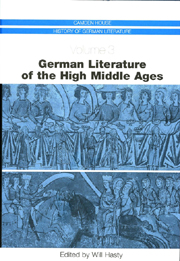Book contents
- Frontmatter
- Contents
- List of Illustrations
- Acknowledgments
- Introduction
- Part I The First Flourishing of German Literature
- Part II Lyric and Narrative Traditions
- Part III Continuity, Transformation, and Innovation in the Thirteenth Century
- Wirnt von Gravenberg's Wigalois and Heinrich von dem Türlin's Diu Crône
- Der Stricker
- Rudolf von Ems
- Ulrich von Liechtenstein
- Konrad von Würzburg
- Wernher der Gärtner
- Part IV Historical Perspectives
- Bibliography
- Notes on the Contributors
- Index
Rudolf von Ems
from Part III - Continuity, Transformation, and Innovation in the Thirteenth Century
Published online by Cambridge University Press: 05 February 2013
- Frontmatter
- Contents
- List of Illustrations
- Acknowledgments
- Introduction
- Part I The First Flourishing of German Literature
- Part II Lyric and Narrative Traditions
- Part III Continuity, Transformation, and Innovation in the Thirteenth Century
- Wirnt von Gravenberg's Wigalois and Heinrich von dem Türlin's Diu Crône
- Der Stricker
- Rudolf von Ems
- Ulrich von Liechtenstein
- Konrad von Würzburg
- Wernher der Gärtner
- Part IV Historical Perspectives
- Bibliography
- Notes on the Contributors
- Index
Summary
RUDOLF VON EMS (ca. 1200–ca. 1255) is one of the most significant and prolific authors in the development of thirteenth-century “post-classical” German narrative literature (ca. 1220–90). His five extant works are thought to have been written in the following order: Der guote Gêrhart (Good Gerhard, ca. 1220–25), Barlaam und Josaphat (ca. 1225–30), Alexander (begun ca. 1230 and continued in the 1240s after the composition of Willehalm von Orlens), Willehalm von Orlens (ca. 1235–40) and the Weltchronik (Chronicle of the World, ca. 1250). These texts are cast in the dominant narrative verse form of the “classical” period (ca. 1170–1220) in their uniform composition in rhyming four beat couplets, but the scope of their subject matter is far greater and more diverse than that encompassed by classical courtly literature.
Although Rudolf is not attested in any historical documents, we nonetheless have a keen sense of his historical presence through the expression of a pronounced authorial identity in his works. The name “Ruodolf” occurs in all his narratives, both as an explicit self-reference or as an acrostic embedded in the text. In an intertextual nod to Hartmann von Aue, Rudolf declares himself in Willehalm von Orlens to be a “dienest man ze Muntfort” (15629), a knight in the service of the counts of Montfort who held lands south east of Lake Constance.
- Type
- Chapter
- Information
- German Literature of the High Middle Ages , pp. 225 - 234Publisher: Boydell & BrewerPrint publication year: 2006



